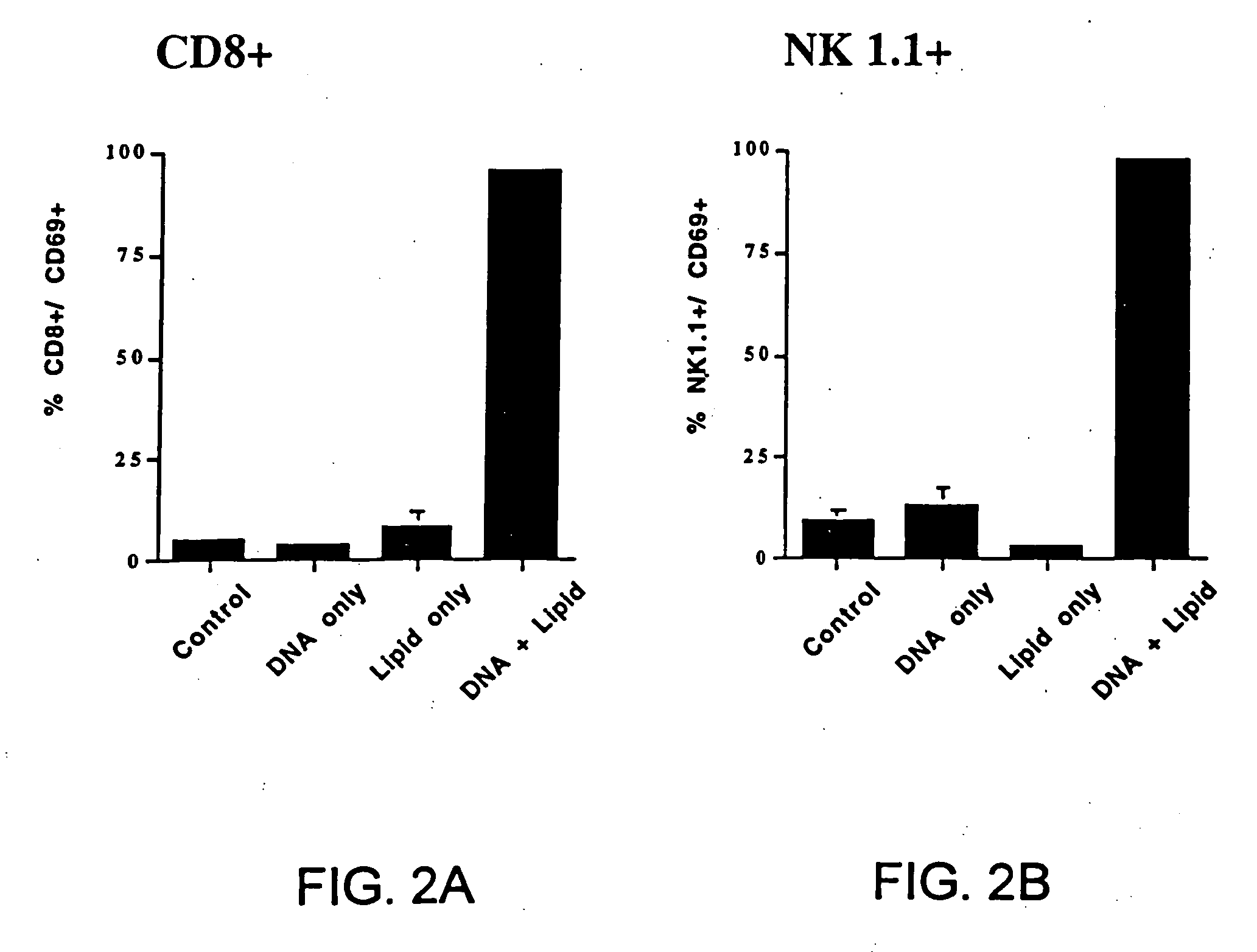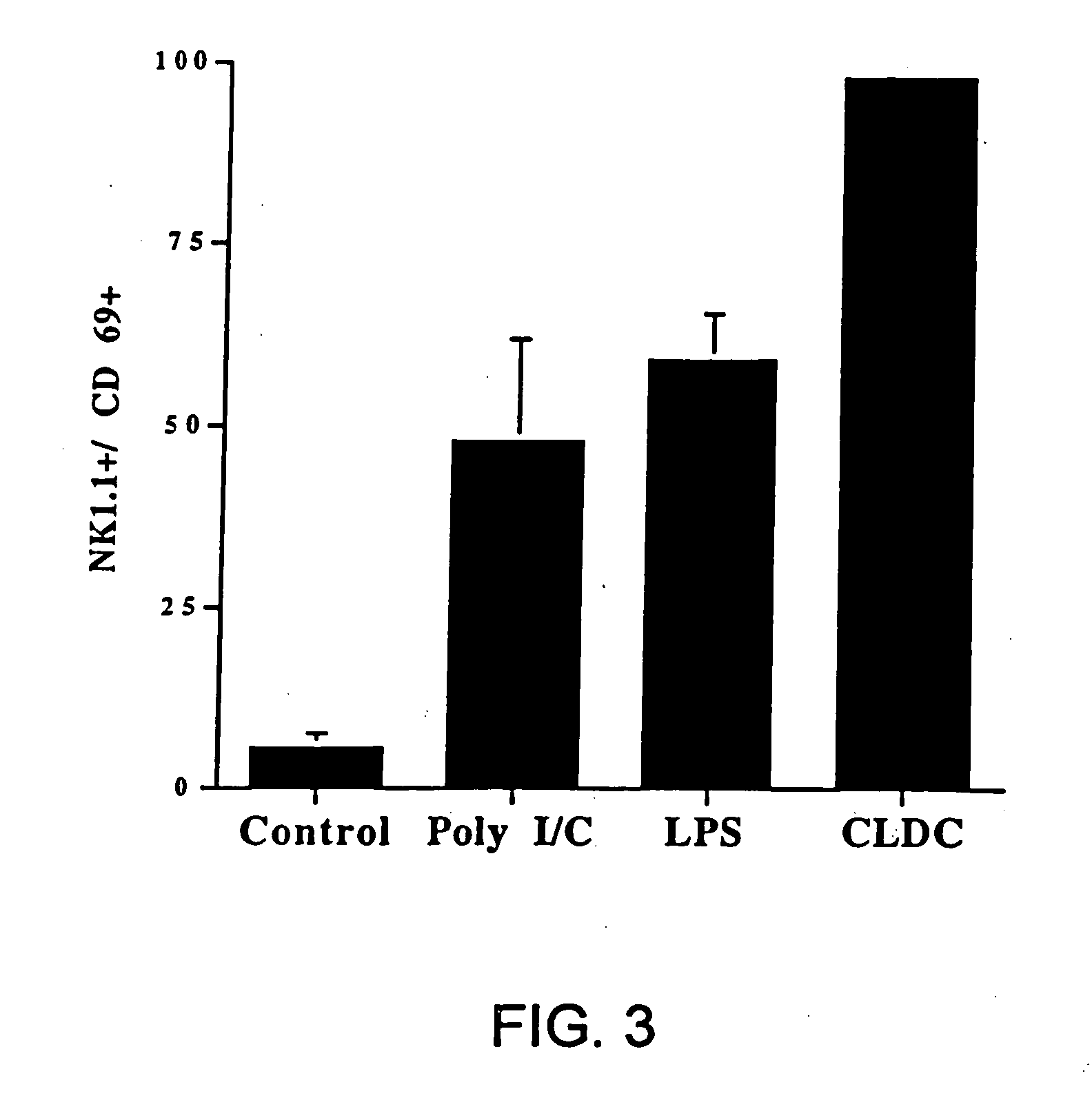Systemic immune activation method using non CpG nucleic acids
a systemic immune activation and nucleic acid technology, applied in the field of systemic immune activation methods using non cpg nucleic acids, can solve the problems of tissue damage and sometimes death, unwanted side effects, and disrupt the dna replication in normal cells in the treated patient, so as to reduce tumors in mammal cells, increase effector cell activity, and increase the effect of ifn
- Summary
- Abstract
- Description
- Claims
- Application Information
AI Technical Summary
Benefits of technology
Problems solved by technology
Method used
Image
Examples
example 1
[0195] The following experiments a-1 and FIGS. 1-12 show that systemically administered cationic liposome DNA complexes (CLDC) formed with non-coding DNA (empty vector) elicit potent immune responses in vivo.
[0196] (a) The following experiment shows that intravenous (i.v.) injection of CLDC containing empty vector DNA induces marked activation of 5 different immune effector cell populations in vivo. In this experiment, CLDC were prepared which consisted of DOTAP and cholesterol mixed in a 1:1 molar ratio complexed with empty vector plasmid DNA (see Section A above). C57B1 / 6 mice were injected intravenously with 100 μl of CLDC (10 μg empty vector DNA per mouse) in DW5 as described (Section C). 24 hours post-injection, spleen cells were harvested from control mice injected with diluent (D5W), and from mice injected with CLDC. Cells were labeled with specific antibodies to evaluate CD4+ and CD8+ T cells, NK cells, B cells, and macrophages and with an antibody to CD69 (early activation...
example 2
[0208] The following experiments a-d and FIGS. 13-16 demonstrate that CLDC formed with non-coding DNA (empty vector) exert potent antitumor effects in vivo when administered according to the method of the present invention.
[0209] (a) The following experiment demonstrates that CLDC exert potent antitumor effects when administered to a mammal by the present method. The antitumor efficacy of CLDC (empty vector) was evaluated in 4 different murine models of metastatic cancer: MCA-205 (C57B1 / 6; fibrosarcoma; FIG. 13A); B16 (C57B1 / 6; melanoma; FIG. 13B); CT26 (BALB / c; colon carcinoma; FIG. 13C); and 4T1 (BALB / c; breast cancer; FIG. 13D). In each model, tumors were established in the lungs of mice (4 per group) by i.v. injection of 2.5×105 tumor cells per mouse (as described in Section I). Three days after the tumor cells were injected, treatment with i.v. administration of 100 μl CLDC was administered (10 μg empty vector DNA complexed to MLV liposomes as described in Sections A and C), a...
example 3
[0213] The following experiment and FIGS. 17A-C show that intravenous injection of CLDC induces selective gene expression in pulmonary tissues. C57B1 / 6 mice were injected i.v. with CLDC encoding a reporter gene, courteously provided by Dr. Robert Debs (luciferase; panel a), and the location of gene expression in various organs was determined 24 hours later (See Sections A, B and C). As shown in FIG. 17A, luciferase gene expression was almost exclusively confined to pulmonary tissues. In FIGS. 17B and 17C, i.v. injection of CLDC encoding IL-2 or IFNγ resulted in efficient intrapulmonary expression of IL-2 and IFNγ, as demonstrated by determination of cytokine expression in lung tissues extracted from the mice. Injection of non-coding CLDC (EV) was included as an additional control.
PUM
| Property | Measurement | Unit |
|---|---|---|
| Fraction | aaaaa | aaaaa |
| Length | aaaaa | aaaaa |
| Ratio | aaaaa | aaaaa |
Abstract
Description
Claims
Application Information
 Login to View More
Login to View More - R&D
- Intellectual Property
- Life Sciences
- Materials
- Tech Scout
- Unparalleled Data Quality
- Higher Quality Content
- 60% Fewer Hallucinations
Browse by: Latest US Patents, China's latest patents, Technical Efficacy Thesaurus, Application Domain, Technology Topic, Popular Technical Reports.
© 2025 PatSnap. All rights reserved.Legal|Privacy policy|Modern Slavery Act Transparency Statement|Sitemap|About US| Contact US: help@patsnap.com



